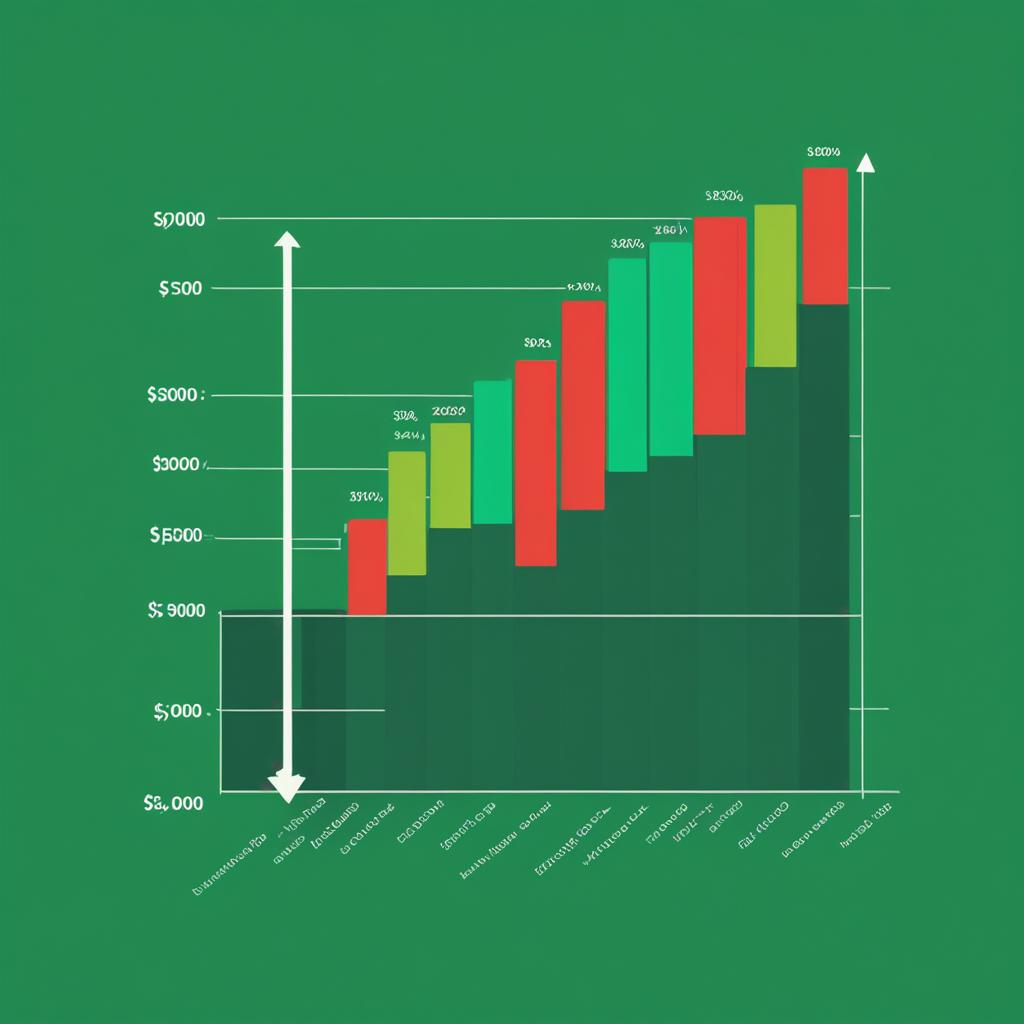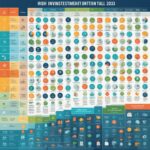If you have $500 that isn’t earmarked for bills, you’re already on the right track to start building long-term wealth. Investing is a smart way to make your money work for you and potentially grow over time. But where should you invest $500? In this guide, I’ll walk you through various investment options and strategies to help you make the most of your $500 investment.
Key Takeaways:
- Diversify your investments across different asset classes to spread risk.
- Consider investing in low-cost index funds or exchange-traded funds (ETFs) for broad market exposure.
- Research and choose reputable investment platforms or institutions for your investments.
- Start small and consistently contribute to your investments to benefit from compounding growth.
- Consult with a financial advisor to create a personalized investment plan based on your goals and risk tolerance.
How to Invest $500 in Stocks
When it comes to investing $500 in stocks, there are a few important factors to consider in order to make the most of your investment. One key consideration is the price per share, as this will determine how many shares you can purchase with your $500 budget. It’s also important to diversify your portfolio by investing in multiple stocks, as this can help mitigate risk and potentially increase your returns over time.
Starting small with investments in multiple stocks can create an opportunity for you to develop a diverse portfolio. With $500, you have the flexibility to buy stocks of smaller companies that are priced as low as $1 or $5 per share. While popular companies like Facebook, Amazon, Apple, Netflix, and Google (collectively referred to as FAANG stocks) may be tempting options, it’s worth exploring lower-priced stocks that have the potential to provide solid returns.
Online brokerages and investment companies offer easy access to buying and selling stocks, making it convenient for investors to manage their portfolios. These platforms provide a wide range of stock options and resources to help you make informed investment decisions. Take advantage of the research tools and educational materials available to gain a better understanding of the stocks you’re interested in.
Remember to keep a long-term perspective when investing in stocks. The value of stocks can fluctuate over time, so it’s important to be patient and give your investments time to grow. Regularly monitor your portfolio and consider making adjustments as needed to align with your financial goals.
Investing $500 in stocks can be a great way to start building your investment portfolio. Whether you’re a beginner or an experienced investor, it’s always a good idea to consult with a financial advisor to get personalized advice and guidance that suits your individual financial situation.
Investing $500 in Bonds
If you’re looking for a less volatile investment option, bonds can be a great choice. Bonds are fixed-income securities that involve lending money to either the government or a corporation in exchange for regular interest payments over a specified period of time.
While bond investments may not yield as high returns as stocks, they offer a lower risk of losing money. Bonds can provide stability and diversification to your investment portfolio, mitigating some of the potential risks associated with stock market fluctuations.
When investing $500 in bonds, it’s important to consider factors such as the bond’s maturity date, interest rate, and credit rating. These factors can impact the overall performance and potential returns of your bond investment.
To help you understand the various types of bonds and their features, below is a table outlining different bond options:
| Bond Type | Description | Features |
|---|---|---|
| Government Bonds | Bonds issued by the government | Backed by the full faith and credit of the government |
| Corporate Bonds | Bonds issued by corporations | Higher potential yield but slightly higher risk |
| Municipal Bonds | Bonds issued by state or local governments | Tax-exempt at the federal level and sometimes at the state level |
| Treasury Bonds | Bonds issued by the U.S. Treasury | Considered low risk and backed by the U.S. government |
As you can see, there are several bond options available, each with its own unique features and considerations. It’s important to research and assess the potential risks and returns associated with each type of bond before making your investment decision.
Remember, bond investments can provide stability to your portfolio, but it’s crucial to diversify your investments and consider your overall financial goals and risk tolerance.
Investing $500 in a High-Yield Savings Account
When it comes to investing $500, a high-yield savings account can be an excellent option. With its emphasis on safety and stability, a high-yield savings account provides a secure avenue for your investment.
To make the most out of your $500 investment, look for high-yield savings accounts that offer an annual percentage yield (APY) greater than the national average. This ensures that your funds can grow at a competitive rate. Regular monthly deposits can further enhance your investment, as the interest generated can compound over time, allowing your money to grow even more.
It’s important to note that accessing the money in a high-yield savings account may result in penalties or reduced earnings. However, this liquidity provides you with the flexibility to use your funds when needed. Whether you’re saving for an emergency or long-term goals, a high-yield savings account offers the convenience of easy access to your money.
Consider the following table that highlights the benefits of investing $500 in a high-yield savings account:
| Benefits | Safe and secure investment |
|---|---|
| Potential for higher returns with a competitive APY | |
| Ability to compound interest with regular deposits | |
| Liquidity and flexibility |
Overall, investing $500 in a high-yield savings account is a prudent choice for those seeking a low-risk option with the potential for steady growth. While it may not yield as high of returns as other investment options, the safety and convenience of a high-yield savings account make it a suitable choice for those starting their investment journey.
Investing $500 in Certificates of Deposit (CDs)
When it comes to investing $500, Certificates of Deposit (CDs) are a popular choice for those seeking low-risk investments. With CDs, you can earn interest over a fixed period of time while enjoying the peace of mind that comes from investing with a reputable institution that is FDIC insured. This means that even if the institution fails, your money is protected.
CDs offer a simple and straightforward investment option. You deposit your money into a CD account for a specified duration, often ranging from a few months to several years, and in return, you receive a fixed interest rate. At the end of the term, you can withdraw your initial investment along with the earned interest.
It’s important to note that CDs typically have a minimum deposit requirement, which can vary depending on the financial institution and the specific CD product you choose. However, with $500, you will generally have various CD options available to you.
One consideration when investing in CDs is the maturity date. Withdrawing your money before the maturity date may result in a withdrawal penalty, which can eat into your returns. Therefore, it’s essential to carefully consider the duration of the CD and ensure that you won’t need the funds before the term is up.
To maximize your returns, it’s wise to shop around and compare CD rates offered by different banks and credit unions. Look for competitive interest rates that will help your money grow over time. You can also consider options such as jumbo CDs, which often offer higher rates for larger investments.
CDs provide a reliable investment option for those who prioritize capital preservation and a guaranteed rate of return. However, keep in mind that the interest rates for CDs are generally lower compared to riskier investments like stocks. The trade-off is the security and stability that CDs offer.
If you’re willing to explore different investment avenues, consider diversifying your portfolio by combining CDs with other investment options. This can help offset any potential limitations of CDs and provide a balanced approach to growing your wealth over time.
If you’re comfortable with a low-risk investment strategy and interested in a predictable return on your $500 investment, CDs can be a valuable addition to your investment portfolio.
The Benefits of Investing in CDs:
- Low-risk investment
- Guaranteed rate of return
- FDIC insured
- Choice of varying durations
- Opportunity to diversify your investment portfolio
Investing $500 in CDs allows you to take advantage of a secure investment option while earning interest over time. Consider your financial goals, risk tolerance, and time horizon when making investment decisions, and remember that diversification is key to building a comprehensive investment strategy.
“Investing in CDs provides a stable foundation for growing your wealth without subjecting your investment to market volatility. It’s a reliable option for those seeking predictable returns and a secure place to park their money.”
Investing $500 with Robo-Advisors
When it comes to investing $500, robo-advisors can be an excellent option. These automated investment platforms use technology to manage your investments based on your financial goals and risk tolerance. With as little as $500, you can start investing with a robo-advisor and enjoy the benefits of automated investing.
Robo-advisors offer several advantages for investors with limited funds. One of the key benefits is their ability to build and manage a diversified portfolio on your behalf. By investing in a variety of assets, such as stocks, bonds, and ETFs, robo-advisors help spread your risk and increase the likelihood of positive returns.
Another advantage of investing with robo-advisors is the low fees they charge. Traditional investment advisors often charge higher fees, which can eat into your returns. Robo-advisors, on the other hand, utilize technology to streamline their operations and pass on the cost savings to investors.
When it comes to choosing a robo-advisor, there are several reputable platforms you can consider. One popular option is Acorns, a robo-advisor that specializes in helping investors get started with small amounts of money. Acorns offers a user-friendly platform and a range of investment options to suit your needs.
With robo-advisors, investing $500 has never been easier. These platforms provide a simple and accessible way to start growing your wealth. Whether you’re a beginner or an experienced investor, automated investing with $500 can set you on the path to long-term financial success.
The Benefits of Investing $500 with Robo-Advisors:
- Automated portfolio management based on your financial goals and risk tolerance
- Diversified investment portfolio to spread risk and increase potential returns
- Low fees compared to traditional investment advisors
- User-friendly platforms with a range of investment options
A Comparison of Robo-Advisor Platforms
| Robo-Advisor | Minimum Investment | Management Fees | Key Features |
|---|---|---|---|
| Acorns | $0 | $1 – $5 per month | Round-up spare change, automatic rebalancing |
| Wealthfront | $500 | 0.25% per year | Tax-efficient investment strategies, financial planning tools |
| Betterment | $0 | 0.25 – 0.40% per year | Goal-based investing, socially responsible investing |

Investing $500 in an Individual Retirement Account (IRA)
If you’re looking to invest $500 for your retirement, an Individual Retirement Account (IRA) is a great option. With an IRA, you can take advantage of tax benefits while saving for your future. Let’s explore how you can make the most of your $500 investment in an IRA.
Choosing the Right IRA Option
There are two main types of IRAs: traditional and Roth. With a traditional IRA, your contributions may be tax-deductible, reducing your taxable income. However, you’ll pay taxes on withdrawals in retirement. On the other hand, a Roth IRA offers tax-free withdrawals in retirement, but contributions are made with after-tax dollars.
Consider your long-term retirement goals and consult with a financial professional to determine which IRA option is best suited for you.
Investing in Stocks, Bonds, or Mutual Funds
Once you’ve opened an IRA, you can start investing your $500 in a variety of securities. You have the flexibility to choose from stocks, bonds, or mutual funds, depending on your risk tolerance and investment goals.
Remember, diversifying your investments is important to reduce risk and optimize returns.
Benefits of Investing in an IRA
There are several advantages to investing in an IRA. First, your contributions grow tax-free until you make withdrawals in retirement. This allows your money to compound over time, potentially earning substantial returns.
Second, an IRA provides a level of financial security for your retirement. By consistently contributing over the years, you’ll build a nest egg that can supplement other sources of retirement income.
Investing $500 in Other Financial Structures
Aside from traditional investment accounts, there are various financial structures that you can explore for investing your $500. These alternative options provide different advantages and align with specific financial goals and timelines. Take a look at some of the popular alternatives:
1. 401(k)s
A 401(k) is a retirement savings plan offered by many employers. By investing your $500 in a 401(k), you can take advantage of tax benefits and potentially receive employer matching contributions. A 401(k) offers a long-term investment opportunity to grow your savings for retirement.
2. 403(b)s
Similar to a 401(k), a 403(b) is a retirement savings plan specific to nonprofit organizations, educational institutions, and certain public entities. By contributing $500 to a 403(b), you can optimize your retirement savings and benefit from tax advantages.
3. 457s
A 457 plan is a retirement savings account available to state and local government employees, as well as some nonprofit organizations. By allocating your $500 to a 457 plan, you can save for retirement while potentially deferring taxes on your contributions and investment gains.
4. 529 Plans
A 529 plan is a tax-advantaged savings account designed to help individuals save for future education expenses. By investing $500 in a 529 plan, you can contribute to your child’s or loved one’s education fund, with the potential for tax-free growth and withdrawals when used for qualified education expenses.
5. Health-Savings Accounts (HSAs)
An HSA is a tax-advantaged medical savings account available to individuals with high-deductible health insurance plans. By utilizing $500 in an HSA, you can save for current and future medical expenses while enjoying potential tax benefits, including tax-deductible contributions and tax-free withdrawals for qualified medical expenses.
6. Real Estate Investment Trusts (REITs)
REITs are investment vehicles that allow you to pool your money with other investors to invest in real estate properties and earn a share of the income generated. With $500, you can explore REIT options, providing exposure to the real estate market without the need for direct ownership or large initial investments.
Consider the benefits and align them with your financial goals and preferences. It’s always a good idea to consult with a financial advisor who can guide you in making an informed decision based on your specific circumstances.
Pay Down Debt with $500
When it comes to investing $500, one of the most effective strategies is to pay down high-interest debt. By prioritizing debt reduction, you can not only save money on interest payments but also improve your overall financial situation. Here are some debt reduction strategies to consider:
- Identify and Prioritize: Start by identifying all your outstanding debts, including credit cards, loans, and any other forms of debt. Then, prioritize them based on their interest rates. Focus on paying off the debts with the highest interest rates first.
- Create a Budget: Develop a budget that allows you to allocate a portion of your $500 towards debt repayment each month. Cut back on unnecessary expenses to free up more money for debt payments.
- Make Extra Payments: Apart from making the minimum payments, try to allocate extra funds from your $500 towards your high-interest debts. Even small additional payments can make a significant impact on reducing your debt faster.
- Negotiate Lower Interest Rates: Contact your creditors and lenders to negotiate for lower interest rates. Exploring lower interest options can help you save money and accelerate your debt repayment progress.
- Consider Debt Consolidation: If you have multiple debts with varying interest rates, debt consolidation might be a viable option. Look for opportunities to consolidate your debts into a single loan with a lower interest rate.
“Paying off debt frees up more money for future investments and positively impacts your credit score.”
Remember, paying off debt is a crucial step towards achieving financial freedom and establishing a solid foundation for future investments. By using your $500 to pay down debt, you can decrease your financial burden and set yourself up for success in the long run.

Invest $500 in a Side Hustle
If you’re looking to make the most of your $500 investment, starting a side hustle or small business can be a fantastic opportunity. With $500, you have the potential to create additional income streams and even grow your venture into a full-time business. Here are some ideas on how you can invest your $500 in a side hustle:
- Flipping items: Buy low-cost items from thrift stores, yard sales, or online platforms, and resell them at a profit.
- Offering services: Utilize your skills or talents to provide services such as freelance writing, graphic design, virtual assistance, or tutoring.
- Selling products online: Set up an e-commerce store or sell products on existing platforms like Etsy or eBay.
To make your side hustle successful, consider using a portion of your $500 investment for the following:
- Purchasing necessary supplies or inventory
- Investing in marketing materials or advertising
- Setting up a website or online presence
By allocating your investment wisely, you can establish a solid foundation for your side hustle and increase your chances of profitability. Remember, building a successful business takes time and effort, so be prepared to dedicate yourself to your side hustle.
Consider a DRIP (Dividend Reinvestment Plan)
Grow your investments with a Dividend Reinvestment Plan (DRIP)
When looking to invest $500 in dividend-paying stocks, consider a Dividend Reinvestment Plan (DRIP). With a DRIP, you can utilize compound interest to maximize your investments over time.
In a DRIP, you use your $500 to purchase dividend-paying stocks and reinvest the dividends back into buying more stocks. This strategy allows you to take full advantage of the power of compound interest, as your investments grow both through stock price appreciation and through the reinvestment of dividends.
By reinvesting your dividends, you can acquire more shares of the company’s stock, which further increases your potential for future dividend payments. Over time, the number of shares you own will accumulate, leading to an exponential growth of your investments.
To find companies that offer dividend reinvestment plans, research established companies with a history of consistent dividend payments. Look for dividend aristocrats or companies in stable industries that have a track record of increasing their dividends over time. These companies often provide the option to reinvest dividends through a DRIP.

Visualizing the potential of dividend reinvestment, here is a table summarizing the growth of a $500 investment in dividend-paying stocks with and without a DRIP strategy over a 10-year period:
| Investment Strategy | Final Value after 10 years |
|---|---|
| Investing $500 in dividend-paying stocks without DRIP | $XXX |
| Investing $500 in dividend-paying stocks with DRIP | $XXX |
Quote: “A DRIP allows you to harness the power of compound interest and steadily grow your investments over time.” – [Author Name]
By reinvesting your dividends through a DRIP, you can experience significant growth in your investments. However, it’s important to note that past performance is not indicative of future results, and investing in stocks always carries a level of risk. Consider consulting with a financial advisor to determine the best course of action based on your financial goals and risk tolerance.
Buy Savings Bonds with $500
When it comes to low-risk investments, savings bonds backed by the US government are a popular choice. Investing $500 in savings bonds allows you to earn interest over time while enjoying stability and security. While the returns on savings bonds may not be as high as other investment options, they provide a reliable foundation for your portfolio.
To explore the options for buying savings bonds, consider the various types available and how they align with your investment goals and timeline. You can choose between Series EE and Series I savings bonds, each with its own features and potential benefits.
Series EE Savings Bonds:
- These bonds are purchased at face value and accrue interest over 30 years.
- They offer a fixed rate of return, making them ideal for long-term savings goals.
- You can redeem Series EE savings bonds after 12 months, but it is recommended to hold them longer for optimal returns.
Series I Savings Bonds:
- This type of bond offers a combination of a fixed interest rate and an inflation rate component that adjusts every six months.
- Series I savings bonds protect against inflation and can provide a higher return compared to Series EE bonds.
- They are held for a minimum of 12 months and can be redeemed after 5 years without penalty.
Before making a decision, take into account your investment goals, time horizon, and risk tolerance. Savings bonds can be a valuable addition to a diversified portfolio, providing stability and a consistent source of income.
“Investing in savings bonds is a reliable way to grow your money with minimal risk. They offer the peace of mind that comes with government backing, making them suitable for conservative investors looking for stable returns over time.”
Remember, it’s essential to consult with a financial advisor to determine the best investment strategy based on your unique circumstances and financial goals.
Start a 529 College Savings Plan with $500
Investing $500 in a 529 college savings plan is a smart way to prepare for your child’s higher education expenses. With a 529 plan, you can set aside funds specifically for college costs and take advantage of tax benefits.
A 529 plan allows you to contribute regularly and watch your savings grow over time. By starting early and making consistent contributions, you can maximize the growth potential of your investment.
One of the great advantages of a 529 plan is its flexibility. The funds can be used at most accredited colleges and universities, both in-state and out-of-state. This means that regardless of where your child decides to attend college, the savings will be available to support their education.
When opening a 529 plan with $500, consider your child’s education goals. Are they planning to attend a private or public college? Will they pursue a degree in-state or out-of-state? Understanding their aspirations will help you set realistic savings targets and create a plan that meets their needs.
Consulting with a financial advisor can provide further guidance on how to maximize the benefits of a 529 plan. They can help you understand the tax advantages, contribution limits, and investment options available to you.
Start investing in your child’s future today by opening a 529 college savings plan with $500. It’s a valuable tool to help ensure they have the financial support they need to pursue their dreams.

“Education is the most powerful weapon which you can use to change the world.” – Nelson Mandela
Diversify with Real Estate and REITs
Investing in real estate and real estate investment trusts (REITs) can be a valuable addition to your investment portfolio. Real estate offers the potential for long-term growth and income opportunities, while REITs allow you to invest in real estate properties without the need for direct ownership.
With $500, you can explore crowdfunding platforms or REITs that offer real estate investment opportunities. One reputable option is Fundrise, a platform that allows investors to pool their funds and invest in a diversified portfolio of real estate projects across the United States.
Fundrise provides access to a range of real estate assets, including residential properties, commercial buildings, and even large-scale development projects. By investing in a professionally managed portfolio of properties, you can benefit from potential rental income, property value appreciation, and diversification across different real estate sectors.
Here is a table showcasing the potential benefits of investing in real estate and REITs:
| Benefits | Explanation |
|---|---|
| Income Generation | Real estate investments can provide regular rental income, offering a potential source of passive income. |
| Long-Term Appreciation | Real estate values tend to appreciate over time, allowing you to potentially earn substantial returns on your investment. |
| Diversification | Investing in real estate and REITs can diversify your investment portfolio, reducing overall risk. |
| Tax Advantages | Real estate investments offer various tax benefits, such as depreciation and deductions for expenses. |
It’s important to research and choose reputable platforms or REITs that align with your investment goals and risk tolerance. Consider consulting with a financial advisor to ensure real estate investments fit well within your overall investment strategy.
Conclusion
Investing $500 is a smart way to start building long-term wealth and securing your financial future. By diversifying your investments and giving your money time to grow, you can make the most of your $500. There are several options available, including stocks, bonds, high-yield savings accounts, certificates of deposit (CDs), and alternative investment structures.
When deciding how to invest your $500, it’s important to think about your long-term goals and consult with a financial advisor if needed. Investing in stocks can provide potential growth, while bonds offer stability and less risk. High-yield savings accounts and CDs provide security and a way for your money to grow over time.
Consider exploring other investment structures like robo-advisors, individual retirement accounts (IRAs), or even using your $500 to pay off high-interest debt. Regardless of the investment option you choose, remember that every dollar invested counts and can make a difference in your financial future. Take the necessary steps to establish a solid investment strategy and watch your wealth grow over time.
FAQ
What are some popular options for investing 0?
Popular options include stocks, bonds, high-yield savings accounts, certificates of deposit (CDs), ETFs, mutual funds, IRAs, and alternative investments.
How can I invest 0 in stocks?
Consider buying stocks of smaller companies for as little as
FAQ
What are some popular options for investing $500?
Popular options include stocks, bonds, high-yield savings accounts, certificates of deposit (CDs), ETFs, mutual funds, IRAs, and alternative investments.
How can I invest $500 in stocks?
Consider buying stocks of smaller companies for as little as $1 or $5 per share. Explore popular companies like FAANG stocks (Facebook, Amazon, Apple, Netflix, Google) or lower-priced stocks. Online brokerages and investment companies offer easy access to buying and selling stocks.
What should I know before investing $500 in bonds?
Bonds are fixed-income securities where you lend money to the government or a corporation and receive interest over time. They offer stability and diversification in your portfolio. Take into account the risk and potential returns compared to stocks.
What is a high-yield savings account and how can I invest $500 in one?
A high-yield savings account is a safe option that offers greater interest rates than traditional savings accounts. Look for accounts with an annual percentage yield (APY) higher than the national average. Regular monthly deposits and compounding interest can help your money grow. Be aware of potential penalties or reduced earnings when accessing the money.
How can I invest $500 in certificates of deposit (CDs)?
CDs are low-risk investments that offer fixed interest rates over a specific period. Purchase CDs through reputable institutions that are FDIC insured. Look for competitive interest rates and be aware of potential withdrawal penalties if you need to access the money before the maturity date.
What are robo-advisors and how can I invest $500 with them?
Robo-advisors are automated investment platforms that manage your investments based on your financial goals and risk tolerance. Start investing with as little as $500. They offer low fees and simplified investment options. Consider platforms like Acorns or other reputable robo-advisors.
What is an Individual Retirement Account (IRA) and how can I invest $500 in one?
An IRA is a tax-advantaged account that helps you save for retirement. With $500, you can open an IRA and invest in stocks, bonds, or mutual funds. Choose between a traditional IRA or a Roth IRA, considering the tax benefits and withdrawal rules.
What other financial structures can I consider for investing $500?
Other options include 401(k)s, 403(b)s, 457s, 529 plans, health-savings accounts, and real estate investment trusts (REITs). Each structure offers different advantages and aligns with specific financial goals and timelines.
Is it worth paying down debt with $500?
Yes, paying down high-interest debt can save you money on interest payments and improve your financial situation. Consider prioritizing credit card debt or loans with higher interest rates.
Can I invest $500 in a side hustle?
Yes, you can use $500 to start a side hustle or small business. This investment can go towards necessary supplies, marketing materials, or setting up a website. Explore different side hustle opportunities and potentially grow it into a full-time business.
What is a DRIP (Dividend Reinvestment Plan) and can I invest $500 in one?
A DRIP is a strategy where you use $500 to purchase dividend-paying stocks and reinvest the dividends to buy more stock over time. This approach utilizes compound interest to grow your investments. Look for companies that offer dividend reinvestment plans and consider the long-term potential for dividend growth.
How can I buy savings bonds with $500?
Savings bonds are low-risk investments backed by the US government. With $500, you can purchase savings bonds that earn interest over time. While they may have lower returns compared to other investments, they provide stability and security.
How can I start a 529 college savings plan with $500?
You can open a 529 plan with $500 and regularly contribute towards funding future education costs. These plans offer tax advantages and can be used at most accredited colleges and universities.
Can I invest $500 in real estate or REITs?
Yes, you can invest in real estate and REITs with $500. Explore crowdfunding platforms or REITs that allow you to invest in properties without direct ownership. Research reputable options and consider the potential long-term growth and income opportunities.
What is the key to investing $500?
The key is to diversify your investments and give your money time to grow. Consider a mix of different investment options and consult with a financial advisor if needed to develop a solid investment strategy aligned with your long-term goals.
or per share. Explore popular companies like FAANG stocks (Facebook, Amazon, Apple, Netflix, Google) or lower-priced stocks. Online brokerages and investment companies offer easy access to buying and selling stocks.
What should I know before investing 0 in bonds?
Bonds are fixed-income securities where you lend money to the government or a corporation and receive interest over time. They offer stability and diversification in your portfolio. Take into account the risk and potential returns compared to stocks.
What is a high-yield savings account and how can I invest 0 in one?
A high-yield savings account is a safe option that offers greater interest rates than traditional savings accounts. Look for accounts with an annual percentage yield (APY) higher than the national average. Regular monthly deposits and compounding interest can help your money grow. Be aware of potential penalties or reduced earnings when accessing the money.
How can I invest 0 in certificates of deposit (CDs)?
CDs are low-risk investments that offer fixed interest rates over a specific period. Purchase CDs through reputable institutions that are FDIC insured. Look for competitive interest rates and be aware of potential withdrawal penalties if you need to access the money before the maturity date.
What are robo-advisors and how can I invest 0 with them?
Robo-advisors are automated investment platforms that manage your investments based on your financial goals and risk tolerance. Start investing with as little as 0. They offer low fees and simplified investment options. Consider platforms like Acorns or other reputable robo-advisors.
What is an Individual Retirement Account (IRA) and how can I invest 0 in one?
An IRA is a tax-advantaged account that helps you save for retirement. With 0, you can open an IRA and invest in stocks, bonds, or mutual funds. Choose between a traditional IRA or a Roth IRA, considering the tax benefits and withdrawal rules.
What other financial structures can I consider for investing 0?
Other options include 401(k)s, 403(b)s, 457s, 529 plans, health-savings accounts, and real estate investment trusts (REITs). Each structure offers different advantages and aligns with specific financial goals and timelines.
Is it worth paying down debt with 0?
Yes, paying down high-interest debt can save you money on interest payments and improve your financial situation. Consider prioritizing credit card debt or loans with higher interest rates.
Can I invest 0 in a side hustle?
Yes, you can use 0 to start a side hustle or small business. This investment can go towards necessary supplies, marketing materials, or setting up a website. Explore different side hustle opportunities and potentially grow it into a full-time business.
What is a DRIP (Dividend Reinvestment Plan) and can I invest 0 in one?
A DRIP is a strategy where you use 0 to purchase dividend-paying stocks and reinvest the dividends to buy more stock over time. This approach utilizes compound interest to grow your investments. Look for companies that offer dividend reinvestment plans and consider the long-term potential for dividend growth.
How can I buy savings bonds with 0?
Savings bonds are low-risk investments backed by the US government. With 0, you can purchase savings bonds that earn interest over time. While they may have lower returns compared to other investments, they provide stability and security.
How can I start a 529 college savings plan with 0?
You can open a 529 plan with 0 and regularly contribute towards funding future education costs. These plans offer tax advantages and can be used at most accredited colleges and universities.
Can I invest 0 in real estate or REITs?
Yes, you can invest in real estate and REITs with 0. Explore crowdfunding platforms or REITs that allow you to invest in properties without direct ownership. Research reputable options and consider the potential long-term growth and income opportunities.
What is the key to investing 0?
The key is to diversify your investments and give your money time to grow. Consider a mix of different investment options and consult with a financial advisor if needed to develop a solid investment strategy aligned with your long-term goals.
Our Friends
- https://smartasset.com/investing/how-to-invest-500-dollars
- https://millennialmoney.com/how-to-invest-500-dollars/
- https://www.clevergirlfinance.com/how-to-invest-500/
Money posts:
 How to Invest $1 Million Dollars: Strategies and Tips for Growth and Security
How to Invest $1 Million Dollars: Strategies and Tips for Growth and Security
 12 Best Investments for 2024
12 Best Investments for 2024
 11 Best Low-Risk Investments with High Returns in 2024
11 Best Low-Risk Investments with High Returns in 2024
 Best Ways to Start Investing for College Students (2024)
Best Ways to Start Investing for College Students (2024)
 12 Best Ways to Invest $5000 Dollars (2024)
12 Best Ways to Invest $5000 Dollars (2024)
 Best Short-Term Investments for September (2024)
Best Short-Term Investments for September (2024)
 13 Best Compound Interest Accounts & Investments (2024)
13 Best Compound Interest Accounts & Investments (2024)
 13 Best High-Yield Investments for 2024
13 Best High-Yield Investments for 2024

